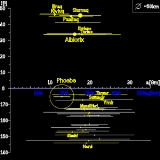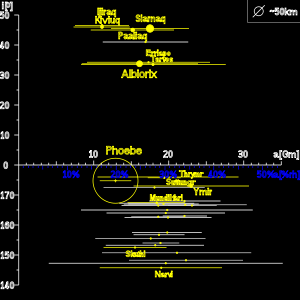
Saturn's Gallic group of satellites
Encyclopedia
The Gallic group is a dynamical grouping of the prograde
irregular satellite
s of Saturn
following similar orbit
s. Their semi-major axes
range between 16 and 19 Gm, their inclination
s between 35° and 40°, and their eccentricities around 0.53.
 The International Astronomical Union
The International Astronomical Union
(IAU) reserves names taken from Gallic mythology
for these moons.
Similar mean orbital elements led the discoverers to postulate a common origin for the group in a break up of a larger body.
The diagram illustrates the Gallic group in relation to other irregular satellites of Saturn. The eccentricity of the orbits is represented by the yellow segments (extending from the pericentre
to the apocentre
) with the inclination represented on Y axis.
The four members of the group are (in order of increasing distance from Saturn):
The group was later found to be physically homogenous, all satellites displaying light-red colour (colour indices
B − V = 0.91 and V − R = 0.48)
and similar infrared
indices
Remarkably, recent observations revealed that the largest member of the group, Albiorix
, displays actually two different colours: one compatible with Erriapus and Tarvos, and another less red. Instead of the common progenitor, it was postulated that Tarvos and Erriapus could be fragments of Albiorix, leaving a large, less red crater.
Such an impact would require a body with the diameter in excess of 1 km and relative velocity close to 5 km/s, resulting in a large crater with the radius of 12 km. Numerous, very large craters observed on Phoebe
, prove the existence of such collisions in the Saturnian system's past.
Prograde
Prograde can refer to:*Prograde or direct motion, in astronomy, a type of motion of astronomical bodies* Prograde metamorphism, in geology, describes mineral changes in rocks under increasing pressure and/or temperature conditions...
irregular satellite
Irregular satellite
In astronomy, an irregular moon is a natural satellite following a distant, inclined, and often eccentric and retrograde orbit. They are believed to have been captured by their parent planet, unlike regular satellites, which form in situ....
s of Saturn
Saturn
Saturn is the sixth planet from the Sun and the second largest planet in the Solar System, after Jupiter. Saturn is named after the Roman god Saturn, equated to the Greek Cronus , the Babylonian Ninurta and the Hindu Shani. Saturn's astronomical symbol represents the Roman god's sickle.Saturn,...
following similar orbit
Orbit
In physics, an orbit is the gravitationally curved path of an object around a point in space, for example the orbit of a planet around the center of a star system, such as the Solar System...
s. Their semi-major axes
Semi-major axis
The major axis of an ellipse is its longest diameter, a line that runs through the centre and both foci, its ends being at the widest points of the shape...
range between 16 and 19 Gm, their inclination
Inclination
Inclination in general is the angle between a reference plane and another plane or axis of direction.-Orbits:The inclination is one of the six orbital parameters describing the shape and orientation of a celestial orbit...
s between 35° and 40°, and their eccentricities around 0.53.

International Astronomical Union
The International Astronomical Union IAU is a collection of professional astronomers, at the Ph.D. level and beyond, active in professional research and education in astronomy...
(IAU) reserves names taken from Gallic mythology
Celtic mythology
Celtic mythology is the mythology of Celtic polytheism, apparently the religion of the Iron Age Celts. Like other Iron Age Europeans, the early Celts maintained a polytheistic mythology and religious structure...
for these moons.
Similar mean orbital elements led the discoverers to postulate a common origin for the group in a break up of a larger body.
The diagram illustrates the Gallic group in relation to other irregular satellites of Saturn. The eccentricity of the orbits is represented by the yellow segments (extending from the pericentre
Apsis
An apsis , plural apsides , is the point of greatest or least distance of a body from one of the foci of its elliptical orbit. In modern celestial mechanics this focus is also the center of attraction, which is usually the center of mass of the system...
to the apocentre
Apsis
An apsis , plural apsides , is the point of greatest or least distance of a body from one of the foci of its elliptical orbit. In modern celestial mechanics this focus is also the center of attraction, which is usually the center of mass of the system...
) with the inclination represented on Y axis.
The four members of the group are (in order of increasing distance from Saturn):
- AlbiorixAlbiorix (moon)Albiorix is a prograde irregular satellite of Saturn. It was discovered by Holman, et al. in 2000, and given the temporary designation S/2000 S 11.Albiorix is the largest member of the Gallic group of irregular satellites....
- Bebhionn
- Erriapus
- TarvosTarvos (moon)Tarvos , or Saturn XXI, is a prograde irregular satellite of Saturn. It was discovered by John J. Kavelaars et al. on September 23, 2000, and given the temporary designation S/2000 S 4...
The group was later found to be physically homogenous, all satellites displaying light-red colour (colour indices
Color index
In astronomy, the color index is a simple numerical expression that determines the color of an object, which in the case of a star gives its temperature...
B − V = 0.91 and V − R = 0.48)
and similar infrared
Infrared
Infrared light is electromagnetic radiation with a wavelength longer than that of visible light, measured from the nominal edge of visible red light at 0.74 micrometres , and extending conventionally to 300 µm...
indices
Remarkably, recent observations revealed that the largest member of the group, Albiorix
Albiorix (moon)
Albiorix is a prograde irregular satellite of Saturn. It was discovered by Holman, et al. in 2000, and given the temporary designation S/2000 S 11.Albiorix is the largest member of the Gallic group of irregular satellites....
, displays actually two different colours: one compatible with Erriapus and Tarvos, and another less red. Instead of the common progenitor, it was postulated that Tarvos and Erriapus could be fragments of Albiorix, leaving a large, less red crater.
Such an impact would require a body with the diameter in excess of 1 km and relative velocity close to 5 km/s, resulting in a large crater with the radius of 12 km. Numerous, very large craters observed on Phoebe
Phoebe (moon)
Phoebe is an irregular satellite of Saturn. It was discovered by William Henry Pickering on 17 March 1899 from photographic plates that had been taken starting on 16 August 1898 at the Boyden Observatory near Arequipa, Peru, by DeLisle Stewart...
, prove the existence of such collisions in the Saturnian system's past.

